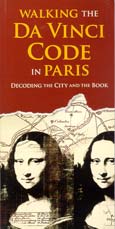|
|
| Paris Home | Sightseeing |
| Where to Stay | Transportation |
|
|
Walking the Da Vinci Code in Paris
|
 |
Walking the Da Vinci Code in Paris Peter Caine Paperback, 224 pages Avalon Travel Publishing US $13.95 |
Dan Brown's bestselling novel-turned-movie, The Da Vinci Code, has inspired a boom in tours inspired by the adventures of Robert Langdon and Sophie Neveu, ranging from Parisian walks (see Viator's Paris tours listings) to Trafalgar's multiple-country, 15-day "Trail of Da Vinci Tour."
Of all the Da Vinci Code travel spinoffs, one of the best values is Peter Caine's book, Walking the Da Vinci Code in Paris. The handsomely printed trade paperback has a teaser inside the front cover that encapsulates the book's mission:
"One of the most common questions I'm asked by readers is where they can go to see all of the art, architecture, locations, and symbols described in the book?" - Dan Brown
"The answer, I hope, can be found in this book." - Peter Caine
Walking the Da Vinci Code in Paris begins with a short discussion of the novel and its major settings, then takes the reader around "Dan Brown's Paris" in five chapters and three appendices, all of which are illustrated with attractive photos, artwork, and/or maps.
Chapter 1, "The Paving Stones of Paris," explains why Dan Brown had Robert Langdon and Sophie Neveu travel around the city by what some critics have called "impractical" or "impossible" routes. (See Excerpt 1). It includes two self-guided walking tours and "Sophie and Langdon's Occult Guide to Paris."
"Beneath the Rose Line" is about the Church of St-Sulpice, including "The Story of St-Sulpice: The key to the quest for the Holy Grail."
"Under the Pyramids" is a guided Da Vinci Code tour of the Louvre, with photos and discussions of important paintings and locations in the museum and the novel.
"Ch‚teau Villette and Beyond" takes you to the suburbs, and to local curiosities such as the Musťe Tavet-Delacour with its mummified leg of Marie de Medici, which was saved from the destruction of the royal tombs at St-Denis.
"The Keystone: Paris Practicalities" is a very brief city guide (so brief that we're surprised the editors bothered to include it).
"Appendix 1: The Seven Seals" discusses the symbols in The Da Vinci Code (with drawings), the controversial issues raised by the novelist, and an English-language bookstore in Paris where you can buy some of the books that Dan Brown used in his research.
"Appendix 2: Inside the Cryptex" contains a "who's who" of characters in the novel (with blurbs about places related to the characters or their adventures) and a glossary about terms, codes, and famous people such as Leonardo da Vinci and Victor Hugo.
"Appendix 3: Isis and the Sacred Feminine" explains some of the theory on which The Da Vinci Code was based, with topics that range from ancient Coptic codices to the role of Isis in Parisian history and symbolism.
About the author:
Peter Caine has lived in Paris for 20 years. He and his wife Oriel are the founders of Paris Walks, which includes a Da Vinci Code itinerary in its menu of walking tours.
Our recommendation:
Peter Caine is intimately familiar with Paris and The Da Vinci Code, and his enthusiasm for both topics comes through in this beautifully illustrated guidebook. If you're a fan of the Dan Brown novel or the movie and you aren't taking a tour (or even if you are), Walking the Da Vinci Code in Paris deserves a place in your travel bag or coat pocket.
Next page: Excerpt 1: Reasons for roundabout routes
| In this article: |
| Book Review: Walking the Da Vinci Code in Paris |
| Excerpt 1: Reasons for roundabout routes |
| Excerpt 2: The Arc de Triomphe |
| Excerpt 3: Sophie's world: Sandrine Bieil |
|
|